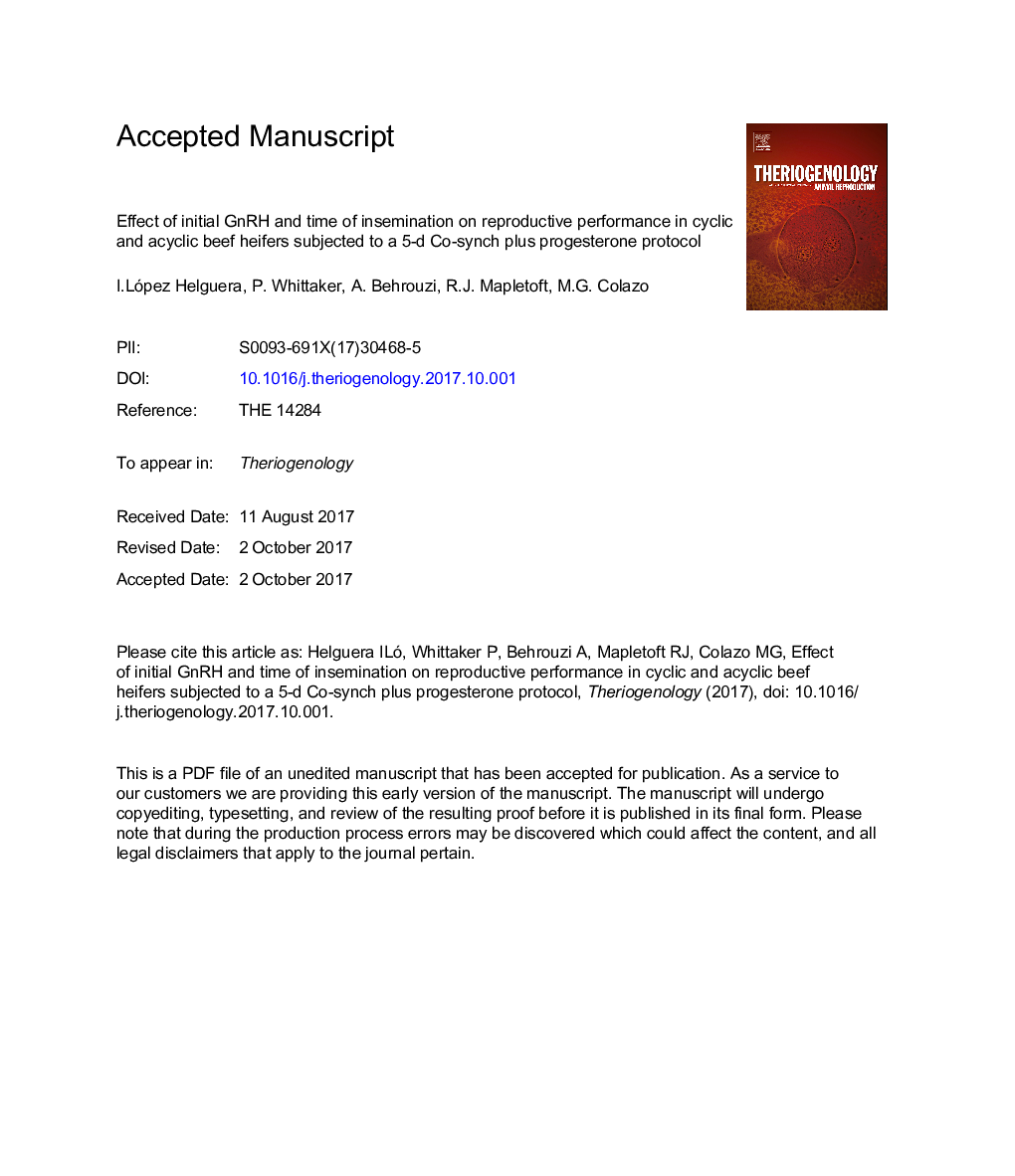| کد مقاله | کد نشریه | سال انتشار | مقاله انگلیسی | نسخه تمام متن |
|---|---|---|---|---|
| 8427778 | 1546063 | 2018 | 29 صفحه PDF | دانلود رایگان |
عنوان انگلیسی مقاله ISI
Effect of initial GnRH and time of insemination on reproductive performance in cyclic and acyclic beef heifers subjected to a 5-d Co-synch plus progesterone protocol
دانلود مقاله + سفارش ترجمه
دانلود مقاله ISI انگلیسی
رایگان برای ایرانیان
موضوعات مرتبط
علوم زیستی و بیوفناوری
علوم کشاورزی و بیولوژیک
علوم دامی و جانورشناسی
پیش نمایش صفحه اول مقاله

چکیده انگلیسی
This study evaluated the effect of initial GnRH and timing of AI in a 5-d Co-synch plus CIDR (device containing 1.38 g of progesterone) protocol on pregnancy per AI (P/AI) and pregnancy loss in beef heifers. A secondary objective was to determine if the effect of initial GnRH on reproductive performance was influenced by cyclicity. Crossbred beef heifers (n = 1068; 301-514 kg of body weight, and 13-15 mo of age) at three locations were assigned to either a 5-d Co-synch plus CIDR protocol with (CIDR5G) or without (CIDR5NG) an initial injection of 100 μg of GnRH at CIDR insertion (Day 0). All heifers received a single dose of 500 μg of cloprostenol at CIDR removal (Day 5) and were divided into two groups to receive GnRH and TAI at either 66 or 72 h (Day 8) after CIDR removal. All heifers were inseminated by one technician with frozen-thawed semen from 1 of 4 sires available commercially. Transrectal ultrasonography was performed on Day 0 to determine cyclicity (presence of CL) and normalcy of the reproductive track, and 27 d after TAI to determine pregnancy status. Non-pregnant heifers (n = 470) were assigned to either a CIDR5G or a CIDR5NG protocol with TAI at 72 h after CIDR removal. Twelve days after second AI, heifers were exposure to bulls for 20 d and pregnancy diagnoses were performed approximately 30 d after second TAI and 60 d after bulls were removed to diagnose bull pregnancies and determine pregnancy loss rate. The percentage of acyclic heifers was 20.3%. Overall P/AI after first TAI was 55.6% (594/1068) and did not differ between CIDR5G and CIDR5NG (56.1 vs. 55.1%), or between TAI66 and TAI72 (55.8 vs. 55.4%). However, cyclic heifers were more likely to become pregnant than acyclic ones (59.3 vs. 41.2%; P < 0.01). Moreover, acyclic heifers subjected to the CIDR5NG had fewer P/AI than those subjected to CIDR5G (P < 0.01). Overall P/AI after resynchronization was 55.1% and did not differ between CIDR5G and CIDR5NG (51.3 vs. 59.0%). Overall pregnancy loss after first and second TAI were 3.0% (18/594) and 3.9% (8/205), respectively. When pregnancy loss data were combined, synchronization protocol (4.1 vs. 2.3% for CIDR5NG and CIDR5G; P = 0.01), cyclicity (5.8 vs. 2.9% for acyclic and cyclic; P = 0.03) and the interaction between synchronization protocol and cyclicity (P = 0.04) were significant. The overall cumulative pregnancy at the end of the breeding season was 94.2% (1006/1068); acyclic heifers were less likely to be pregnant at the end of the breeding season (88.4 vs. 95.8%; P < 0.01). In summary, the initial GnRH administration in a 5-d Co-synch plus CIDR protocol that includes a single PGF treatment is necessary in acyclic beef heifers to optimize P/AI, but not in cyclic heifers. Moreover, omission of initial GnRH was associated to greater pregnancy losses, particularly in acyclic heifers. Timing of AI did not affect P/AI.
ناشر
Database: Elsevier - ScienceDirect (ساینس دایرکت)
Journal: Theriogenology - Volume 106, 15 January 2018, Pages 39-45
Journal: Theriogenology - Volume 106, 15 January 2018, Pages 39-45
نویسندگان
I. López Helguera, P. Whittaker, A. Behrouzi, R.J. Mapletoft, M.G. Colazo,